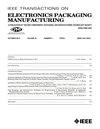Experimental Evaluations of the Strength of Silicon Die by 3-Point-Bend Versus Ball-on-Ring Tests
IEEE Transactions on Electronics Packaging Manufacturing
Pub Date : 2008-05-28
DOI:10.1109/ITHERM.2008.4544335
引用次数: 40
Abstract
Silicon wafers and dies are made of single crystalline material in semiconductor applications which must withstand high stresses within electronic packages. The apparent mechanical strength of single-crystalline Si depends on process induced defects. Mechanical bending tests are the simplest way to obtain the strength of Si dies and wafers and have been used for many years throughout the industry. Some of the bending tests, such as the 3-point-bend (3PB) test, provide a convoluted contribution from both the defects on die surface (caused by backgrinding and mishandling) and defects on die edges (caused by sawing or dicing). However, the ball-on-ring (BOR) test provides a way to single out the contribution of backside grinding defects to the die strength. This paper compares the results of both 3PB and BOR tests on a number of backgrinding and dicing processes. The die strength of the 3PB test is consistently less than that of the BOR test due to the fact that the edge defects are under tension for 3PB tests but not for BOR. It is demonstrated that the BOR test is a good method for backgrinding process optimization. Due to the intrinsic scattering nature of the strength data, a Weibull-based probabilistic mechanics approach is the method of choice to present the data.硅模三点弯曲与球环试验强度的实验评价
在半导体应用中,硅片和晶片是由单晶材料制成的,必须承受电子封装中的高应力。单晶硅的表观机械强度取决于工艺缺陷。机械弯曲测试是获得Si模具和晶圆强度的最简单方法,在整个行业中已使用多年。一些弯曲测试,如三点弯曲(3PB)测试,提供了模具表面缺陷(由背景研磨和不当处理引起)和模具边缘缺陷(由锯切或切割引起)的复杂贡献。然而,球环(BOR)测试提供了一种方法来挑选出背面磨削缺陷对模具强度的贡献。本文比较了3PB和BOR在若干背磨和切粒工艺上的试验结果。3PB试验的模具强度始终小于BOR试验,这是由于3PB试验的边缘缺陷处于拉伸状态,而BOR试验的边缘缺陷处于拉伸状态。结果表明,BOR试验是一种优化背磨工艺的好方法。由于强度数据固有的散射特性,采用基于威布尔的概率力学方法来表示强度数据是一种选择。
本文章由计算机程序翻译,如有差异,请以英文原文为准。
求助全文
约1分钟内获得全文
求助全文

 求助内容:
求助内容: 应助结果提醒方式:
应助结果提醒方式:


